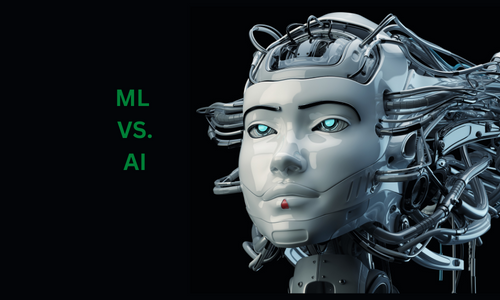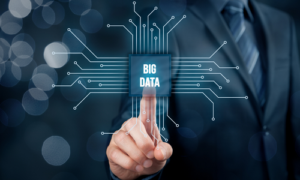Machine Learning (ML) and Artificial Intelligence (AI) are both parts of Computer Science that are linked and are intelligent machines. These are used for developing solid and intelligent systems. Both of them have a lot in common, but still, both of them are two different things.
Artificial Intelligence is a more extensive term that composes Machine Learning. Even. Artificial Intelligence helps in developing machines to simulate human behavior and capability. On the other hand, Machine Learning allows machines to learn from the provided data without typically being programmed.
Content:
- Artificial Intelligence
- Types of Artificial Intelligence
- Machine Learning
- Types of Machine Learning
- Key Differences between AI and ML
- Conclusion
Artificial Intelligence
Artificial Intelligence is the computer’s ability to work like humans and perform the tasks humans are supposed to do. AI caters to tasks requiring thinking, reasoning, and learning from past experiences. AI can make decisions on its own.
AI is advancing a lot, but still, it cannot act as a human being regarding feelings and emotions. Some of the most commonly used practical applications of AI are
- Robots
An industrial robot is an excellent invention of AI which can detect and solve problems independently. It can efficiently work in a new environment and detect problems, which lessens human efforts.
- Personal Assistants
The most common personal assistants are Sirri, Alexa, Cortana, etc., who help humans open different applications and perform different tasks without holding the device.
Types of Artificial Intelligence
Artificial Intelligence is divided into three types:
- Artificial Narrow Intelligence
- Artificial General Intelligence
- Artificial Super Intelligence
- Artificial Narrow Intelligence (ANI)
ANI is also called weak intelligence because it is a goal-oriented approach designed for performing specific tasks like speech assistants, speech recognition, image recognition, face recognition, car driving or web surfing, etc. it can only perform a task that it is programmed to do. Human behavior is stimulated in ANI based on specific measures and context. The results depend on the amount of training data.
- Artificial General Intelligence (AGI)
AGI is also called Strong AI or Deep AI. AGI has a solid ability to mimic human behavior and intelligence. It uses its own intelligence to solve problems and can think and understand the situation before acting on it. The researchers and scientists have not yet reached the level of AGI. The basic idea of AGI is to understand human beings and act like humans.
- Artificial Super Intelligence (ASI)
ASI is beyond ANI and AGI, where machines surpass human intelligence and ability and work with complex patterns. ASI has behavior patterns, emotions, and feelings of its own. ASI exceeds in every aspect like medicine, arts, science, sports, mathematics, relationships, etc. it has a sharp memory and a remarkable ability to process and analyze data well. The problem-solving ability of ASI is much better than humans and faster as well.
Machine Learning
Machine Learning is the subpart of Artificial Intelligence that learns from the previous data and then suggests things accordingly. ML enables the computer program to learn without being programmed explicitly. The machine makes accurate predictions after learning the patterns and seeing the input details. A few of the commonly used applications of machine learning are:
- Recommendations / Suggestions
Most eCommerce websites have ML tools that give customers suggestions based on their choices, likes, preferences, and previous experiences.
- Spam Emails
You may have seen some unwanted emails in the spam folder. These emails are filtered with the help of ML to get into the spam folder instead of the primary inbox.
Types of Machine Learning
ML is divided into three types which are:
- Supervised Learning
- Unsupervised Learning
- Reinforcement Learning
- Supervised Learning
Supervised Learning deals with the already labeled data. It means that a user knows the target variable already. Systems can predict the future using supervised Learning. A model must be trained using past experiences and viable to learn from.
- Unsupervised Learning
The unlabeled data is used in unsupervised Learning to discover patterns from the data on its own. The system can quickly identify hidden elements and features by the input provided by data. The patterns become visible when the data comes in a readable form.
- Reinforcement Learning Algorithm
The basic goal of reinforcement learning is to train any agent for task completion. The agent is trained to work in an uncertain environment. The agent gets the observations and rewards from the environment, and actions are sent to the environment. The tips tell how successful the action was.
Key Differences between AI and ML
| ARTIFICIAL INTELLIGENCE | MACHINE LEARNING |
| The machines imitate human behavior and perform tasks of human beings. | It is the sub-part of AI which allows the machine to learn from past experiences and draw predictions. |
| The primary goal of AI is to design computers for performing human-based tasks. | The primary goal of ML is to learn from the input and then provide an accurate output. |
| AI has extensive scope in terms of its Work. | The scope of ML is quite limited. |
| AI works to perform intricate and complex tasks. | ML works to perform a limited or specific task. |
| AI works to achieve success. | ML works to get accurate results. |
| AI deals with all types of data: Structured, Semi-Structured, and Unstructured. | ML deals with only two types of data: Structured and Semi-Structured data. |
| AI is divided into three types: Weak, General, and Strong AI | AI is divided into three areas: Supervised Learning, Unsupervised Learning, and Reinforcement Learning |
Conclusion
To sum up, both AI and ML are essential inventions of humans. Both AI and ML play a significant role in our lives these days, which helps humans in different ways to save time, effort, and energy. AI can solve tasks requiring human intelligence, whereas ML solves specific tasks they are programmed to do.
Related Articles:







